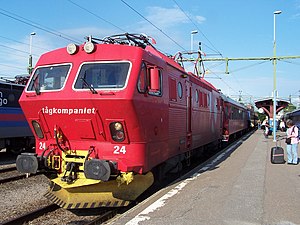This article needs additional citations for verification .(January 2021) |
| NSB El 16 | |||||||||||||||
|---|---|---|---|---|---|---|---|---|---|---|---|---|---|---|---|
 Tågkompaniet train type El16 24, Sundsvall, Sweden (Image taken by Henrik Sendelbach). | |||||||||||||||
| |||||||||||||||
| |||||||||||||||
| |||||||||||||||
| |||||||||||||||
NSB El 16 is an electric locomotive which is used on the Norwegian railway system by CargoNet to haul freight trains. Until it was replaced by the El 18, the El 16 engines also pulled passenger trains on the Norwegian State Railways.
